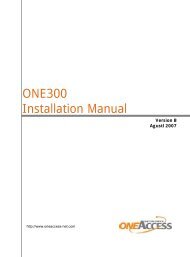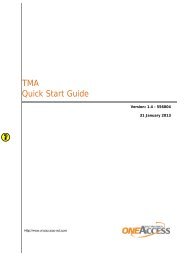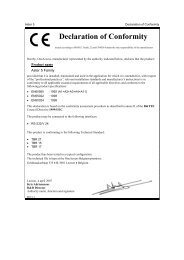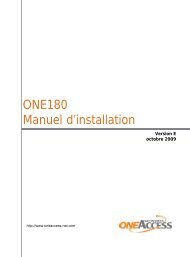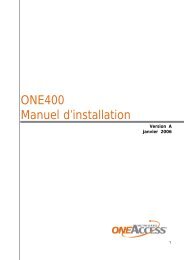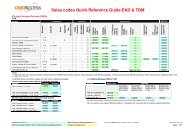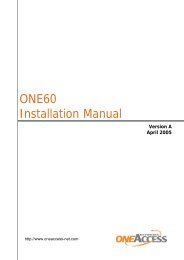1134 & 1135 Web User Guide rev2.0 - OneAccess extranet
1134 & 1135 Web User Guide rev2.0 - OneAccess extranet
1134 & 1135 Web User Guide rev2.0 - OneAccess extranet
Create successful ePaper yourself
Turn your PDF publications into a flip-book with our unique Google optimized e-Paper software.
TELINDUS <strong>1134</strong>/<strong>1135</strong> <strong>Web</strong> Interface <strong>User</strong>’s <strong>Guide</strong>4.6.16 Dynamic RoutingDynamic Routing allows the ADSL Router to automatically adjust to physical changes in thenetwork. The ADSL Router, using the RIP protocol, determines the network packets’ route basedon the fewest number of hops between the source and the destination. The RIP protocol regularlybroadcasts routing information to other ADSL Routers on the network.The Direction determines the direction that RIP routes will be updated. Selecting In means thatthe ADSL Router will only incorporate received RIP information. Selecting Out means that theADSL Router will only send out RIP information. Selecting both means that the ADSL Router willincorporate received RIP information and send out updated RIP information.The protocol is dependent upon the entire network. Most networks support Rip v1. If RIP v1 isselected, routing data will be sent in RIP v1 format. If Rip V2 is selected, routing data will be sentin RIP v2 format using subnet broadcasting. If Rip V1 Compatible is selected, routing data will besent in RIP v2 format using multicasting.To enable Dynamic Routing, click Advanced and under Advanced, select Dynamic Routing.Figure 31 illustrates a typical Dynamic Route.Figure 31 (Dynamic Routing)The Apply button will temporarily save these settings. To make the change permanent, you needto click on Save All Settings. At the System Commands page under the TOOLS, click on SaveAll.Version 1.0 Page 43/54 October 2004




